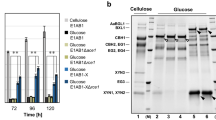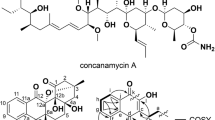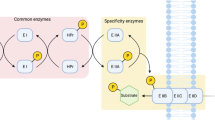Abstract
A set of E. coli transformants (2,500) containing plasmid pBR322 with Thermomonospora YX DNA inserts larger than 3 kb was prepared. The transformants were screened directly for the ability to hydrolyze carboxymethyl cellulose. Two colonies exhibiting cellulase activity were found. One colony contains a plasmid (pD365) that contains a 7.6 kb insert, including the entire gene coding for the major endoglucanase activity of Thermomonospora YX. The other colony (D315) had two plasmids in it: pD316 contains a 8.5 kb insert which includes at least 80% of the major endoglucanase gene; pD315 contains a 6.6 kb insert and does not express cellulase activity. Restriction maps were prepared for each plasmid and the endoglucanase gene was localized to a 2.3 kb SalI fragment in pD316 and to a 3.7 kb EcoRI fragment in pD365. These fragments were subcloned into plasmids containing active promoters regulated by the lactose repressor. The new strains each made about 50 times more cellulase than the original strains. E. coli transformants containing plasmids pD316, pD365 and their derivatives secrete about 30% of their endoglucanase activity into the medium, 30% into the periplasmic space, while 40% remains in the cytoplasm. Thermomonospora YX DNA restriction digests were fractionated by agarose gel electrophoresis and the fragments which hybridized to pD315 and pD316 were detected by nitrocellulose blotting techniques. The results indicated that each plasmid contains a single contiguous segment of Thermomonospora YX DNA and that the pD315 and pD316 inserts are linked in the Thermomonospora YX genome.
This is a preview of subscription content, access via your institution
Access options
Subscribe to this journal
Receive 12 print issues and online access
$209.00 per year
only $17.42 per issue
Buy this article
- Purchase on Springer Link
- Instant access to full article PDF
Prices may be subject to local taxes which are calculated during checkout
Similar content being viewed by others
References
Humphrey, A.E., Moreira, A., Armiger, W., and Zabriskie, D. 1977. Production of single cell protein from cellulose wastes. Biotechnol. Bioeng. Symp. 7: 45–64.
Haggerdahl, B.G.R., Ferchak, J.P., and Pye, E.K. 1978. Cellulolytic enzyme system of Thermomonospora sp. grown on microcrystalline cellulose. Appl. Environ. Microbiol. 36: 606–612.
Whittle, D.J., Kiburn, D.G., Warren, R.A.J., and Miller, R.C., Jr. 1982. Molecular cloning of a Cellulomonas fimi cellulase gene in E. coli. Gene 17: 139–145.
Cornet, P., Tronik, D., Millet, J., and Aubert, J.-P. 1983. Cloning and expression in E. coli of Clostridium thermocellum genes coding for amino acid synthesis and cellulose degradation. FEMS Microbiol. Letts. 16: 137–141.
Teather, R.M. and Wood, P.J. 1982. Use of Congo Red-polysaccharide interactions in enumeration and characterization of cellulytic bacteria from the bovine serum. Appl. Environ. Microbiol. 43: 777–780.
Campbell, J., Richardson, C.C., and Studier, F.W. 1978. Genetic recombination and complementation between bacteriophage T7 and cloned fragments of T7 DNA. Proc. Natl. Acad. Sci. USA 75: 2276–2280.
Miller, J.H., Müller-Hill, B., and Beckwith, J.R. 1968. The i-gene, which codes for the lac repressor, is transcribed in the same direction as the structural genes (Z, y, a) of the lac operon. Nature 220: 1287–1290.
Towbin, H., Staehlin, T., and Gordon, J. 1979. Electrophoretic transfer of proteins from polyacrylamide gels to nitrocellulose sheets: procedure and some applications. Proc. Natl. Acad. Sci. USA 76: 4350–4354.
Renart, J., Reiser, J., and Stark, G.R. 1979. Transfer of proteins from gels to diazobenzyloxymethyl-paper and detection with antisera: a method for studying antibody specificity and antigen structure. Proc. Natl. Acad. Sci. USA 75: 3116–3120.
Southern, E.M. 1975. Detection of specific sequences among DNA fragments separated by gel electrophoresis. J. Mol. Biol. 98: 503–517.
Sutcliffe, J.G. 1979. Complete nucleotide sequence of the E. coli plasmid pBR322. Cold Spring Harbor Symp. Quant. Biol. 43: 77–90.
Rüther, U., Koenen, M., Otto, K., and Müller-Hill, B. 1981. pUR222, a vector for cloning and rapid chemical sequencing of DNA. Nuc. Acids Res. 9: 4087–4098.
de Boer, H.A., Comstock, L.U., and Vasser, M. 1983. The Tac promoter: A functional hybrid derived from the trp and lac promoters. Proc. Natl. Acad. Sci. USA 80: 21–25.
Holmes, D.S. and Quigley, M. 1981. A rapid boiling method for the preparation of bacterial plasmids. Anal. Biochem. 114: 193–197.
Maniatis, T., Fritsch, E.F., and Sambrook, J. 1982. Molecular cloning. Cold Spring Harbor Lab., Cold Spring Harbor, N.Y.
Tanaka, S., Lerner, S.A., and Lin, E.C.C. 1967. Replacement of a phosphoenolpyruvate-dependent phosphotransferase by a nicotinamide adenine dinucleotide-linked dehydrogenase from the utilization of mannitol. J. Bacteriol. 93: 642–648.
Torriani, A. 1980. Influence of inorganic phosphate in the formation of phosphatases in E. coli. Biochim. Biophys. Acta 39: 460–471.
Neu, H.C. and Heppel, L.A. 1965. The release of enzymes from E. coli by osmotic shock and during the formation of spheroplasts. J. Biol. Chem. 240: 3685–3692.
Nelson, N. 1944. A photometric adaptation of the Somogyi method for the determination of glucose. J. Biol. Chem. 153: 375–380.
Miller, G.L., Blum, R., Glennon, W.E., and Burton, A.L. 1960. Measurement of carboxymethyl cellulase activity. Anal. Biochem. 1: 127–132.
Bradford, M. 1976. A rapid and sensitive method for the quantitation of microgram quantities of protein utilizing the principle of protein-dye binding. Anal. Biochem. 92: 248–254.
Pardee, A.B., Jacob, F., and Monod, J. 1959. The genetic control and cytoplasmic expression of “inducibility” in the synthesis of β-galactosidase by E. coli. J. Mol. Biol. 1: 165–178.
Author information
Authors and Affiliations
Rights and permissions
About this article
Cite this article
Collmer, A., Wilson, D. Cloning and Expression of a Thermomonospora YX Endocellulase Gene in E. coli. Nat Biotechnol 1, 594–601 (1983). https://doi.org/10.1038/nbt0983-594
Received:
Accepted:
Issue Date:
DOI: https://doi.org/10.1038/nbt0983-594



